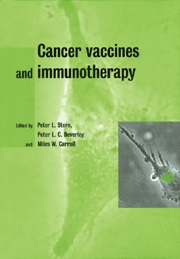Book contents
- Frontmatter
- Contents
- List of contributors
- 1 Immunity and cancer
- 2 Immunotherapy of bladder cancer
- 3 Poxviruses as vectors for cancer immunotherapy
- 4 Vaccinia-based human papillomavirus vaccines in cervical cancer
- 5 Vaccine delivery and immunosuppression in cervical cancer
- 6 Vaccines for colon cancer
- 7 MUC1 vaccines and breast cancer
- 8 Anti-idiotypic vaccination
- 9 Immunotherapy and vaccination against Epstein–Barr virus-associated cancer
- 10 Serologically identified tumour antigens as cancer vaccines
- 11 CTL-defined cancer vaccines in melanoma and other epithelial cancers
- 12 DNA vaccines against B-cell tumours
- 13 Dendritic cell approaches to immunotherapy
- 14 Overview
- 15 Recent developments
- Index
7 - MUC1 vaccines and breast cancer
Published online by Cambridge University Press: 06 January 2010
- Frontmatter
- Contents
- List of contributors
- 1 Immunity and cancer
- 2 Immunotherapy of bladder cancer
- 3 Poxviruses as vectors for cancer immunotherapy
- 4 Vaccinia-based human papillomavirus vaccines in cervical cancer
- 5 Vaccine delivery and immunosuppression in cervical cancer
- 6 Vaccines for colon cancer
- 7 MUC1 vaccines and breast cancer
- 8 Anti-idiotypic vaccination
- 9 Immunotherapy and vaccination against Epstein–Barr virus-associated cancer
- 10 Serologically identified tumour antigens as cancer vaccines
- 11 CTL-defined cancer vaccines in melanoma and other epithelial cancers
- 12 DNA vaccines against B-cell tumours
- 13 Dendritic cell approaches to immunotherapy
- 14 Overview
- 15 Recent developments
- Index
Summary
Features of breast cancer
Breast cancer is the most common malignancy in women in the ‘developed’ world, with the number of new cases per year in the UK and USA being 34000 and 180000, respectively. Breast cancer is rare below the age of 30 but the incidence increases up to the age of 50. Beyond the age of 50, the incidence continues to rise but more slowly compared with premenopausal women. Although the incidence of breast cancer is increasing, recent data suggest that the mortality rate is decreasing. Nevertheless, with a death rate of 20 to 25 per 100000 in the West and a prevalence over three times the incidence, breast cancer continues to be a significant public health problem. Factors conferring an increased risk of breast cancer include mutations in the breast cancer susceptibility genes BRCA-1 and BRCA-2. While mutations in these genes account for the majority of familial breast cancers, they account for only 5 to 10% of all breast cancers. Other factors conferring increased risk include the presence of atypical hyperplasia and carcinoma in situ (cytologically malignant cells confined within a duct or lobule). Obesity, high alcohol consumption, prolonged use of oestrogens and previous radiotherapy to the breast are thought to confer an increase in risk of less than twice the background risk.
The majority of cases of breast cancer present with a lump in the breast which may be associated with nipple discharge and/or deformity of the breast.
- Type
- Chapter
- Information
- Cancer Vaccines and Immunotherapy , pp. 135 - 161Publisher: Cambridge University PressPrint publication year: 2000
- 1
- Cited by



